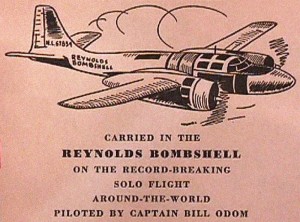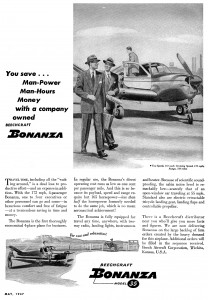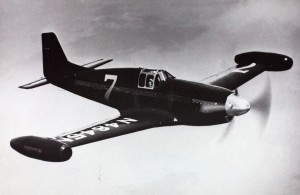Published March 9, 2015
By Thomas Van Hare
On March 7 and 8, 1949, former USAAF pilot Captain William P. “Bill” Odom flew a V-tailed Beech Bonanza that he named, “Waikiki Beech”, from Hawaii to Teterboro, New Jersey. Incredibly, he made it the entire way on “a single tank of gas” — a distance of 5,273 miles in 36 hours and 1 minute. His flight is amazing even today, 65 years later. At the time, it set a new world record for distance in a single-engine aircraft. It also demonstrated just how much aviation had advanced during the war years and helped set off a post-war general aviation boom.

Captain Odom’s Record Flight
Like most early Beech Bonanzas, Captain Odom’s airplane featured just a single engine, the Continental E185, a 185 hp workhorse that would carry many private pilots into the skies in the post-war years. At take-off, Odom’s records showed the plane weighed just 3,858 pounds. He carried full fuel of 288 gallons, using extended-range wing tanks. Based on fuel consumption, he computed that he could easily go more than 5,000 miles with a standard reserve remaining.

Two months earlier, in January 1949, Captain Odom had first tried the flight. In that attempt, he was unsuccessful but still set a record going from Hawaii to California. His intention then had been to go all the way to the East Coast, but bad weather over Nevada had forced him to abandon the remainder of the flight and turn back for California. On this second attempt, weather reports looked more promising. He didn’t waste any time getting off on March 7 from Hickam Field.
Once airborne, he used his knowledge and skill from his years in the USAAF to lean out his engine for maximum endurance — during the war, he had “flown the Hump” in the China-Burma-India theatre (CBI). He had smooth flying across the eastern Pacific but then once over the continental USA, twice the weather intervened. Each time he was able to pick his way through and continue on.

Finally, nearing his destination and while over Ohio, he made good on his plan to look his best for the record-setting arrival. Captain Odom pushed back and let the autopilot do the flying for a bit while he changed into a new set of clothes and took the time to shave. This was no spur-of-the-moment thing either, he had planned it all along and had everything he needed handy in the cockpit.
Thus, he when he landed in Teterboro, he looked like he’d just showed up for a day at the office in clean, neatly pressed pants and shirt. He still had 12 gallons remaining, having burned 272.25 gallons of gas en route. In other words, leaning it way back, he burned just 7.56 gal/hr and kept up an average speed of 127 kts (146.3 mph).
Ever mindful of the limited space available in his logbook for comments, Captain Odom recorded the flight with just these words, “X-country record-breaking flight: 36 hours 01 minutes, Honolulu to Teterboro, New Jersey. Signed Wm. P. Odom.”

The Post-War General Aviation Boom
William Odom’s flight marked a huge advance — the birth of modern general aviation. Flying had gone from being the purview of ranks of a few daring aviators, barnstormers, and the handful of wealthy elites who could afford flight during the hard years of the Great Depression, to a new era of airplanes for all. What followed was a post-war boom that would really take off in the mid-1950s and last until around 1980, when rising fuel, aircraft, and training prices kicked in and dampened the enthusiasm of prospective aviators worldwide.
Back in the late 1940s, just three and a half years after the end of World War II, the world of aviation was resetting from wartime mass production to the new challenge of building aircraft for civilian purposes. There was no doubt that huge strides had been made in aircraft and engine design. Even if it seemed unlikely that the average civilian pilot would afford to run a Packard Merlin V-1650 engine, the advances could be brought down to a reasonable level to meet public demand.
It didn’t take long for civilian manufacturers to realize that thousands of new pilots were returning to civilian life from their previous roles as fighter pilots, bomber pilots, transport pilots, reconnaissance pilots, and more. Many would want to continue flying, if only privately. A key goal for manufacturers was that the costs of flying had to be kept low because it was no longer the government paying for the gas and maintenance!

Companies like Cessna, Piper and Beech quickly stepped up to the plate. By 1947, the Beech Bonanza rolled off the production line and into history — notably, nearly seven decades later, the plane is still in production, though with various upgrades and modernizations.
The promise of civilian aviation was a huge windfall for aviation companies. For Cessna, the post-war boom was its own bonanza (pardon the reverse pun). The Cessna 172, developed in the mid-1950s and still in production today, has become the most-produced airplane in history — more than 43,000 have been built in all. Likewise, Cessna’s venerable C152 has seen a production run of nearly 24,000 and the C182 saw more than 23,000 roll off the assembly line. Piper built and flew nearly 33,000 Cherokees and 20,000 J-3 Cubs, among many other models. The Beech Bonanza too met huge demand with more than 17,000 built and delivered.
To put this into perspective, the most widely-produced aircraft of World War II, the Messerschmitt Me 109, saw a production run of 34,852 aircraft — and that includes post-war, license-built models in Spain (for which production ended in 1958)! The P-51 Mustang, ever a favorite reference, saw just 15,586 examples built. On the British side, 22,685 Supermarine Spitfires were built of all models and variants (including the Seafire). Of course, those great war birds were mostly built during the roughly six-year total period of the war, and at a much higher production rate.

A Sad Aftermath
After Captain Odom’s record-setting flight, he donated the aircraft to the National Air Museum. Today, the “Waikiki Beach” is on display at the Smithsonian’s National Air & Space Museum, Steven F. Udvar-Hazy Center. Most people touring the center, even aviation buffs, have no idea what they are seeing, however. They’re reaction is more on the lines of “Oh look, a V-tailed Bonanza” than the more fitting, “OMG, that plane flew from Hawaii to New Jersey on a single tank of gas — and it only cost $75!”
As for Captain Odom, just six months later, on September 5, 1949, he died in a fiery crash at the Cleveland Air Races. Rounding the second pylon, he pulled back too hard in his war-surplus, highly-modified P-51C Mustang, “The Beguine”. He ended up in an accelerated stall. The plane snapped over and crashed into a house, killing a mother and baby inside as well as himself. His death made national news. Facing public outcry about the races near populated areas, his crash marked the end of the era of air racing in Cleveland.

As for the “Waikiki Beach”, the airplane did not simply retire to the museum. Surprisingly, just a couple of years later in 1951, it was returned to Beech for refurbishing and subsequently rechristened “Friendship Flame”. The Bonanza was flown by Congressman Peter F. Mack, Jr. (himself a former US Navy pilot) on a global goodwill tour in a deeply personal effort to promote peace. Such were the stresses of the early of the Cold War that Congressman Mack saw the opportunity to carry a message of friendship to nearly three dozen different countries. He made the flight and covered over 33,000 miles in 210 hours in the air, making his own headlines all along the way. He also set a new record for a solo flight across the Pacific Ocean and earned the moniker, “The Flying Congressman”.
Looking Back
We don’t know which is more impressive — the distance Captain Odom flew or the low cost. For those wondering, Odom’s reported cost of $75 in 1949, when corrected for inflation, is still only $731 in today’s money. Nonetheless, there’s another point to make about the cost — as of this writing, Air Service Hawaii at Honolulu International charges $6.39/gal for 100LL — and that’s the new, lower price after the worldwide drop in fuel pricing! Thus, the real cost today of the flight would be $1,739.68 just for the fuel, not including the oil, maintenance, or insurance!
In other words, the story of Captain Odom’s flight and the post-war flying boom also highlights the changing cost of AvGas — 100LL has seen an increase in inflation-corrected prices of something around 250 percent (considering the oil charges). That has happened despite the supposed increases in efficiency. Maybe that’s the real reason why the promise of post-war aviation didn’t continue after 1980 and onward to today, despite everyone’s best hopes and dreams. Today’s general aviation sector remains a depressed industry with fewer and fewer new pilots entering training.
It is likely that unless some changes are made, the number of pilots training and getting certificates will continue to decline in the future. It took mankind hundreds of thousands of years to learn to fly and yet, in the course of just a bit more than 100 years, fewer and fewer have the interest or budget to pursue the dream.
A Final Thought
There’s no record as to whether Captain Odom had a hamburger when he arrived in New Jersey, but it would be fitting if he did so.


Great story. Please keep sending more. I’ve missed these daily stories.
We’re intending on doing weekly stories from now on, though it is taking a bit to get things back on track. Also, photo and art features will be published monthly.
Just great! Keep on with these stories!!!
The price of AVGAS100LL reflects the decreasing availability of cheaply-won oil from conventional wells and the necessity to make up for that (as far as possible) with expensively-got unconventional oil (washed tar sand and fracked oil).
More and more of us will fly less and less.
Great article. Wonder if this is the same “Bill” Odum who was sponsored by the Reynolds ballpoint pen company?
Plane type: Douglas A-26 Invader “Reynolds Bombshell”
Date: 1947 Bill Odom Solo round the world flight
From: 08/07/47 To: 08/11/47 (Chicago, IL to Chicago, IL)
Miles flown: 19,645 miles
Flying Time: 73H 5M 11S
Pilot: William P. “Bill” Odom
Comments: Broke all Round-the-World records
Yes, this is the same individual — you have that exactly right. Bear in mind the story of Amelia Earhart to reference just how far aviation had come in the ten years between when she flew (and disappeared) in 1937 and when Bill Odom flew around the world in an A-26 Invader.
Bill Odom was the pilot, Mr. Milton Reynolds (owner of the pen manufacturer) and flight engineer Carroll Sallee made the trip in just 64 hours, 37 minutes flying time, beating the prewar record of 91 hours, 14 minutes set by Howard Hughes in a Lockheed 14.
I go back to your desktop calendar days, and I can’t tell you how glad I am to see the site up and running again. I always look forward to the photos and stories, and the “What’s that” features always get the gears turning.
Thanks for sticking with it.
Sgt Rock.
Just read your story on the flight from Hawaii to NJ. Your side notes hit home for me. My Dad was a USAF pilot and retired after 30 years of active duty. Even considering that his last 6 years were spent “flying a desk”, my Dad logged over 28,000 hours of left seat time and there were no simulators in those times.
I got my private pilot certificate in 1978 in a C-182 and went on to obtain IFR and multi-engine ratings. I have just under 2,500 hours flight time — however, by the late 1980s, I had to move away from General Aviation due to the rising insurance, maintenance and operating costs. I had a C-340 at the time and my hourly operating cost was approaching $200.00 — and these were 1988 dollars!!
I hope to get back into flying but still waiting for $$ to reach my budget!